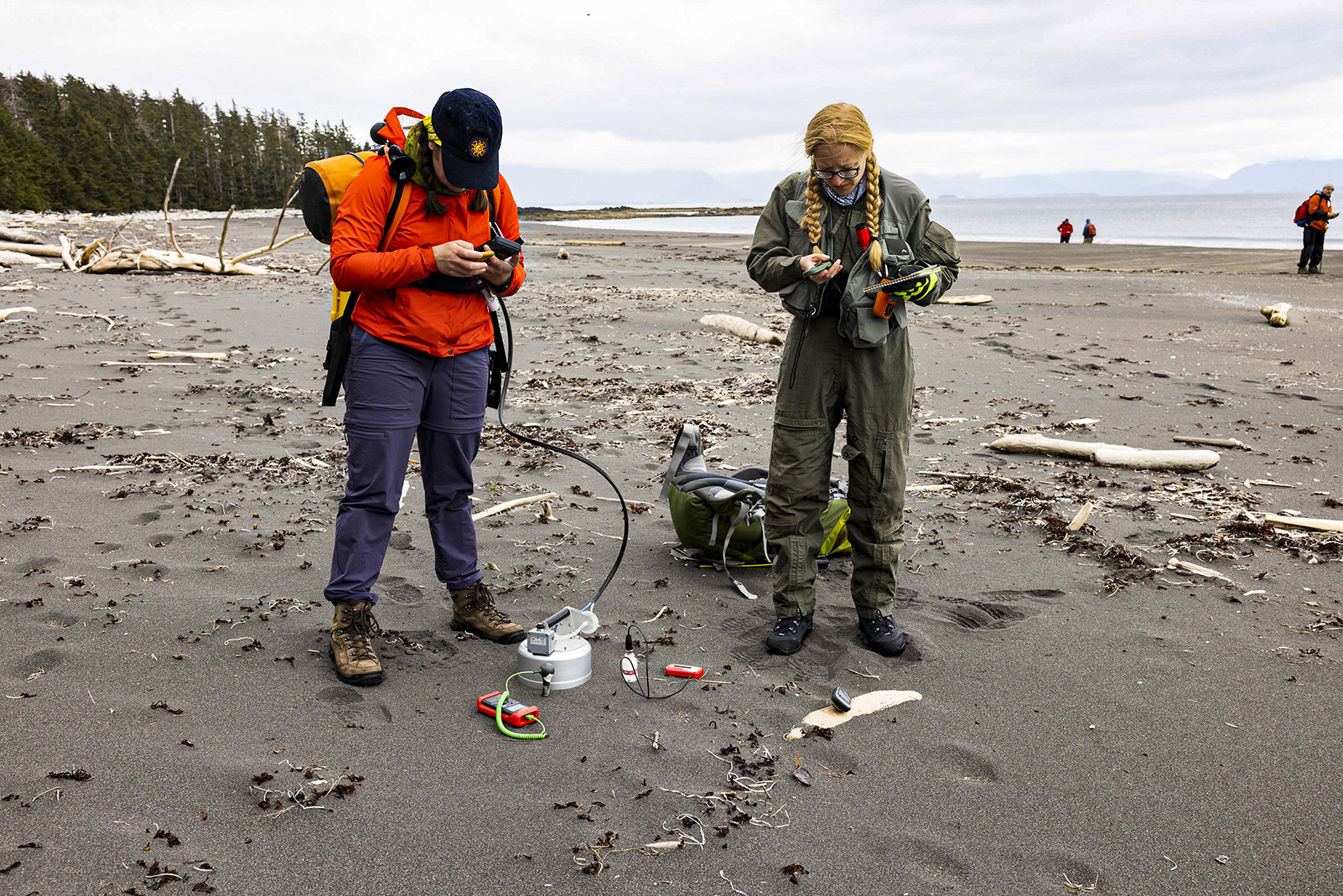International science team explores gassing of Mt. Edgecumbe volcano
Rod Boyce
907-474-7185
June 9, 2023

Graduate student researchers Claire Puleio and Valerie Wasser of the UAF Geophysical Institute take ground carbon dioxide measurements and ground and atmospheric readings on a Kruzof Island beach.
Three pairs of scientists began walking purposefully on one end of a curving Kruzof Island beach on a cloudy, cool and damp Monday, then stopped to take measurements.
The three teams, spaced equally apart up the roughly 500 feet from the incoming tide to the grassy skirt in front of the thick forest, repeated the process every 150 feet or so for the nearly mile-long length of this area of beach.
Walk, stop, measure.
Walk, stop, measure.
At every stop on this site named by the team as “Beach 2,” a 12-inch diameter metal chamber is pressed into the sand to capture and measure any carbon dioxide emitting from the ground. Probes are inserted into the ground to record moisture content and temperature, and atmospheric measurements are also taken.
This was day number two of an international research team’s weeklong field campaign to quantify and later analyze carbon dioxide emissions to gain more insight into the activity of the island’s Mt. Edgecumbe volcano. The volcano reawakened last year, presenting low-level earthquakes and some ground deformation after an approximately 800-year dormancy.
The team includes researchers from the University of Alaska Fairbanks Geophysical Institute, the University of Perugia in Italy and the University of Alicante in Spain. Two of the Geophysical Institute participants are Ph.D. student researchers who did their coursework through the UAF College of Natural Science and Mathematics.
Geophysical Institute Research Assistant Professor Társilo Girona is the principal investigator on the research, which is funded by a NASA program for early career scientists.
The work centers on testing one of Girona’s hypotheses: that a correlation exists between the emergence of low-temperature geothermal anomalies on active volcanoes and the release of carbon dioxide through the ground.
Girona’s team includes UAF graduate student researcher Claire Puleio, who is conducting additional work as part of her Ph.D. project. That research involves the application of satellite-based remote sensing methods, designed by Girona, to locate low temperature geothermal anomalies on Mt. Edgecumbe.
Carbon dioxide is measured in the number of grams per square meter per day. The resulting number is referred to as flux.
Flux readings at this strip of beach weren’t impressive, but they nevertheless have potential use as a baseline against which measurements made elsewhere during this research can be compared.
“In any kind of survey, it's important to know what is normal,” said Carlo Cardellini, associate professor at the University of Perugia Department of Physics and Geology and a collaborator in the project. “It is also called geochemical baseline or background values.”
A post-lunch helicopter jump to a part of Beach 2 a little further south brought flux readings that excited the team. Two of the teams obtained readings far higher than those of the morning.
“We know that low-temperature geothermal anomalies have appeared over the last 20 years in those areas,” Girona said. “This is definitely an area that we want to explore further.”
Whether the source of the higher readings is biologic material or something physical such as a geologic process won’t be known until analysis later in the year.
Monday's fieldwork added to the excitement of Sunday's research.
Aside from the adrenaline rush of a grizzly bear encounter at the start of that first day of work, there was also the excitement of noticing gas bubbling in a shallow beach pond of about 150 feet across. Bubbles wiggled to the surface in five places, all in a line.
Two scientists used an inflatable kayak to reach the bubbles and measure their carbon dioxide content.
The first days of the field research have been good. And they have been aided by good weather in the oft-rainy Sitka region.
“Yes, I think things have been going well,” Girona said.
ADDITIONAL CONTACT: Társilo Girona, University of Alaska Fairbanks Geophysical Institute, tarsilo.girona@alaska.edu.


